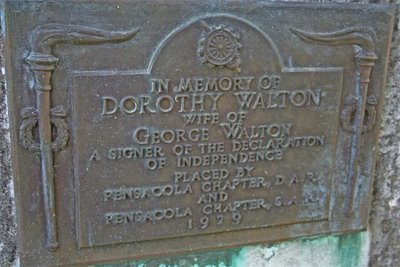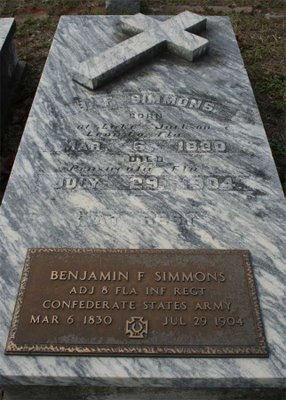
Each year I look forward to the free walking tours sponsored by Pensacola Junior College, led by Professor Randall Broxton. My favorite is the tour of St. Michael's Cemetery which is currently undergoing restoration.

Walking through the cemetery, you will notice names that strike you as familiar. Then you realize you are looking at the resting place of people whose names have been commemorated by streets and towns and counties all around us.

St. Michael's was designated a cemetery almost 200 years ago by the King of Spain and is one of the oldest existing cemeteries in the state of Florida.
From simple to grand, monuments and markers may display a distant country of birth, an inscription of service in war, or verses of grief and loss, all of which give us some small insight to the individual or those who cared for them:
"Goodbye dear Mother, you have left me,
no more on earth your face I'll see,
your tender voice is always with me.
Through your illness I was absent,
yet you asked for me,
my tenderest thoughts was ever with you,
though I was far across the sea."
~~ Monument to Mrs. Eliza Adkison
Born Jan 1, 1820
Died June 20, 1882

A statue of St. Katherine watches over the family tomb of John Williams.

And names frequently reflect the heritage of those who rest there. "Marie" seems to hold some special story.

As ships entered Pensacola Bay during the 1800's, they would drop ballast before replacing it with lumber, cotton, or grain and sailing away to distant ports. Millions of tons of rock and gravel were dumped near Deer Point or along the shore of the bay.
Eventually, enterprising businessmen contracted to recover ballast, then sold it to Pensacolians for use in building homes, foundations, and/or walkways. This photo of the Grant Wheeler tomb in St. Michael's shows a unique use of ballast.
(Use of ballast can also be seen in North Hill homes or around Plaza Ferdinand)

Families of Norwegian sailors lost at sea near Pensacola in 1867 sent money for headstones.

The Spanish Flu epidemic of 1918 killed more than 50 million people world-wide. Such huge numbers are incomprehensible. A tombstone of two young sisters, ages 13 and 18, who died on the same day were most likely victims of influenza that year. But, whether the result of accident or disease, we look at their stone and understand the depth of despair this family suffered.

A Yellow Fever epidemic in 1874 caused the death of 354 of Pensacola's 1400 residents -- a full quarter of the population at that time. Terrified of the disease which was thought to be contracted during the day, the cemetery was lit at night by lanterns of families burying their dead.
One woman, devastated by the loss of so many in her family to yellow fever, wanted to demonstrate her anger to God by refusing to bury them facing east as customary. Instead, the graves are turned north/south.

In the northwest quadrant of the St. Michael's Cemetery is The Priest's Mound which contains graves of several priests and pastors who served the people of Pensacola.

So much history is contained within the boundaries of St. Michael's. Over 3,200 graves are marked, but new GPR technology is being used to locate many more, possibly dating back into the 1790's, leading some to believe the number of graves could actually reach 7,000.
Dedicated volunteers are frequently seen cleaning, repairing and rennovating, fighting the ravages of time and weather as seen etched on this beautiful statue above.

But a more difficult battle is constantly fought against the dark hearts of those who vandalize cemeteries. Who can possibly understand people who rob graves or get a perverse thrill from destroying pieces of our heritage?
St. Michael's has suffered tremendously from vandalism through the years, but the desecration has rallied many to become actively involved in researching and preserving St. Michael's and other local cemeteries.
While researching links which I have included in this post -- and which I encourage you to utilize to learn more about the rich history of Pensacola -- I came across a wonderful quote by a University of West Florida student:
"The vandalized graves are more than slabs of granite," said Siska Williams, a historical archaeology graduate student. "Pensacola's present is rooted in the lives these individuals lived."






4 comments:
GORGEOUS pictures. I love St. Micheal's. It's such a fascinating place, the history there is amazing. I am so glad they are restoring it.
Great job on the picstures!
Dawn
Hi DJ,
I love to visit and photograph old cemetaries. They are so rich in history. Thanks for posting these. Another place I will look forward to visiting my next trip to Pensacola.
cshells
Your photographs are outstanding. Thank you for capturing the beauty of St. Michael’s!
Hi, Siska! I thought I recognized your name and then I realized I had quoted you in my blog. I absolutely loved what you said, "Pensacola's present is rooted in the lives these individuals lived."
Post a Comment